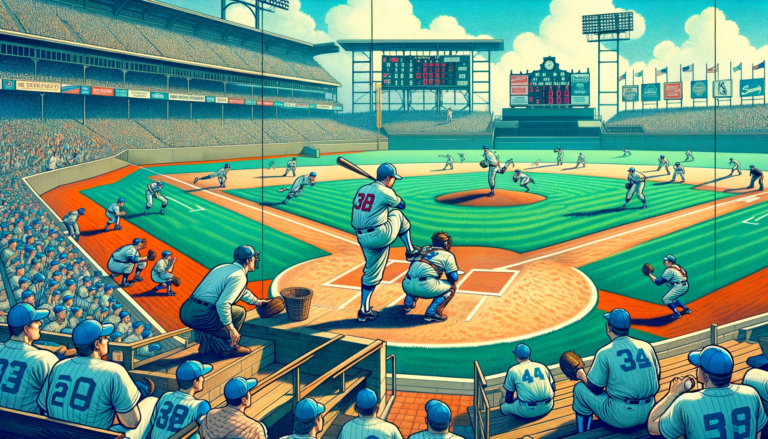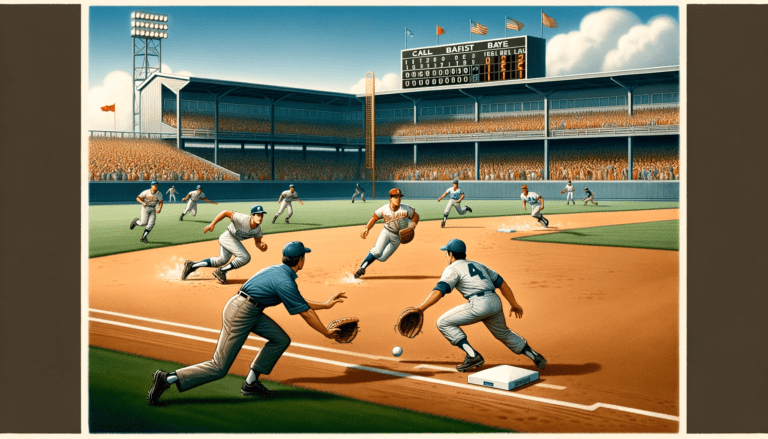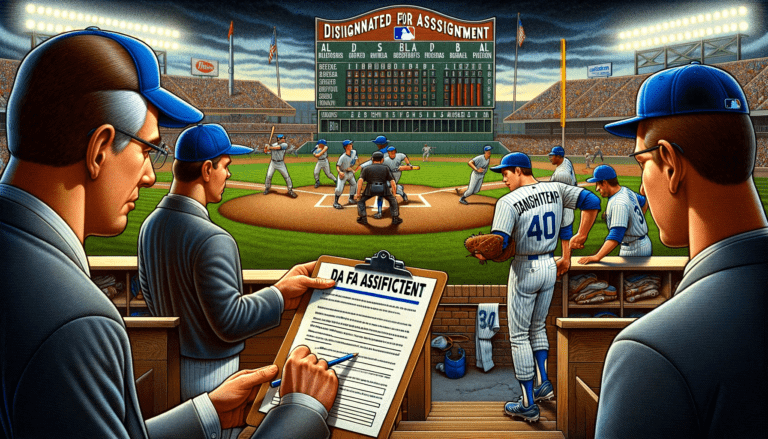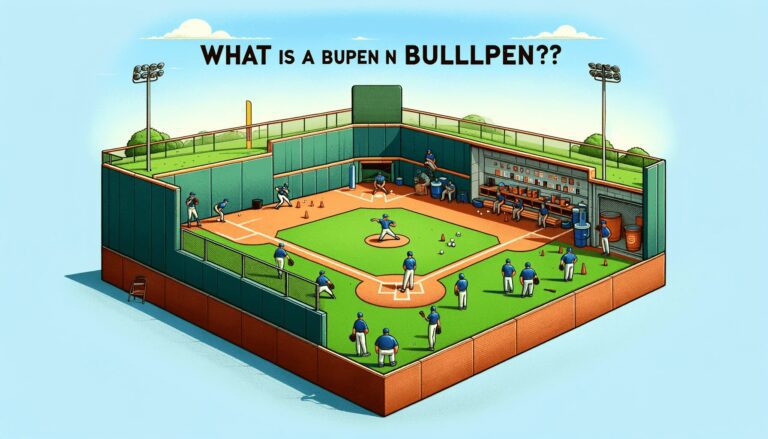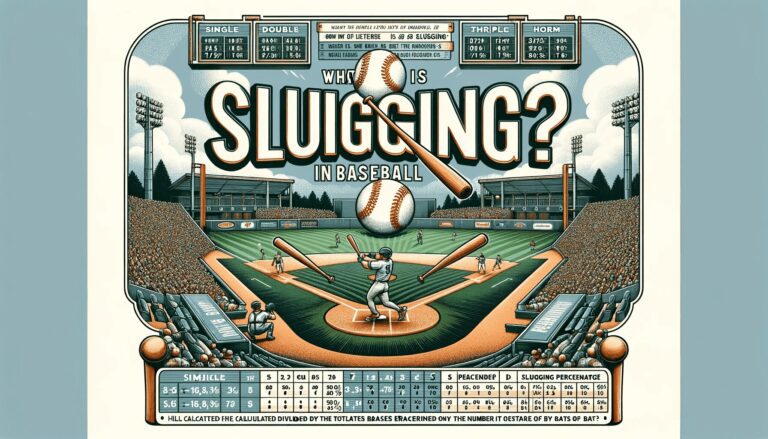What Does a Bat Flip Mean in Baseball?
In baseball, a bat flip refers to the action of letting go of the bat animatedly or exaggeratedly after hitting the ball. This creates a showy, dramatic effect as the player admires and celebrates their hit.
In this article, we’ll explore the meaning behind a bat flip in baseball, exploring its cultural context, controversies, and impact on the game.
Key Takeaways
- Bat flips have transitioned from a frowned-upon gesture to an accepted form of celebration in baseball, reflecting a broader cultural shift towards showmanship.
- The act of flipping a bat can serve as a powerful expression of triumph and can significantly affect team morale and the dynamics between players.
- There is an art to the bat flip, with various styles and techniques that players use to convey their personality and the significance of the moment.
- Despite growing acceptance, bat flips remain contentious, stirring debates between traditionalists and modernists about the ‘unwritten rules’ of baseball.
- Bat flips have permeated popular culture and media, influencing everything from video games to merchandise, thereby cementing their place in baseball lore.
The Evolution of Bat Flip Celebrations in Baseball
Tracing the Origins of Bat Flipping
The act of bat flipping is not a modern invention but rather a practice with deep roots in baseball’s history.
The origins of bat flipping are somewhat nebulous, with no single event marking its inception.
However, the gesture has evolved from a spontaneous act of celebration to a deliberate display of prowess.
In some cultures, bat flipping has been a long-standing tradition. For instance, in Korean baseball, bat flipping is a customary celebration and is widely accepted.
The simple answer to why bat flipping is acceptable in the KBO is because it has always been part of the game there, without the negative connotations it may carry elsewhere.
In the Major Leagues, the attitude toward bat flipping has shifted over time. Early instances were rare and often met with disapproval.
But as the game has modernized, players have become more expressive, and younger fans have come to anticipate these moments of exuberance.
Cultural Shifts and the Acceptance of Showmanship
The bat flip, once considered a taboo in the conservative world of baseball, has undergone a remarkable transformation.
Initially seen as disrespectful, its perception has shifted over time. Today, it symbolizes player expression and the joy of the game, a nod to the evolving culture within the sport.
The acceptance of bat flips can be attributed to several factors:
- A younger generation of players bringing new attitudes and styles to the game.
- Fans’ desire for more entertainment and personality on the field.
- The influence of international players who have long embraced such displays of emotion.
This shift towards showmanship has not only changed the dynamics of player celebrations but also reflects a broader trend in sports towards individuality and flair.
Bat Flip Mechanics have become a part of this new era, where the spectacle is as important as the skill.
Iconic Bat Flips in Baseball History
The history of baseball is peppered with moments where a bat flip has encapsulated the sheer excitement of a game-changing home run.
These iconic bat flips are not just acts of celebration but symbols of memorable victories and personal triumphs.
They serve as bookmarks in the annals of major league baseball in history, each telling a story of its own.
- Jose Bautista’s emphatic bat flip in the 2015 ALDS, which became a defining moment for the Toronto Blue Jays.
- The calculated toss by Yasiel Puig, known for his flair on the field, added drama to the Dodgers’ games.
- Bryce Harper’s bat flip in 2019, which signified a new chapter in his career with the Phillies.
These instances and many others have sparked conversations among fans and players alike, with some viewing them as a breath of fresh air in a tradition-bound sport, while others see them as a breach of the baseball’s unwritten rules and of baseball decorum.
The debate continues, but the allure of the bat flip remains undeniable in the hearts of baseball enthusiasts.
Read Also: What Does Bpf Mean on a Baseball Bat
The Psychology Behind the Bat Flip
Expression of Triumph and Emotion
The bat flip in baseball is more than just a celebratory gesture; it’s a powerful expression of triumph and raw emotion.
After connecting with a pitch and sending the ball soaring, the act of flipping the bat can be seen as the culmination of a player’s hard work and skill, a moment of unbridled joy that is shared with teammates and fans alike.
- It serves as a personal signature on a successful at-bat.
- It can be a spontaneous reaction to the excitement of the moment.
- It often symbolizes the player’s confidence and swagger.
This display of emotion is not just about the individual, but it also resonates with the entire team, injecting energy and enthusiasm into the dugout.
The impact of such a gesture extends beyond the field, as it can influence the morale of both teammates and opponents, sometimes even shifting the momentum of the game.
The Impact on Team Morale and Opponents
The act of flipping a bat after a home run can serve as a powerful psychological tool within the game of baseball.
It can significantly boost the morale of the player’s own team while simultaneously affecting the opposing team’s spirit.
This display of confidence and triumph can energize teammates, reinforcing the belief in their collective strength and capability to win.
For opponents, witnessing a bat flip can be demoralizing. It’s a clear signal that the batter feels victorious and dominant in that moment.
The psychological impact can vary:
- It may motivate the opposing team to respond competitively.
- It could lead to increased tension and a desire for retribution.
- In some cases, it might contribute to a sense of defeat or resignation.
The dynamics of how a bat flip affects both teams’ morale underscores the intricate emotional landscape of baseball, where a single action can ripple through the minds of players and influence the course of the game.
Bat Flips as a Form of Intimidation
The bat flip, often seen as a flamboyant punctuation to a home run, can also serve as a psychological tactic.
Players use bat flips to celebrate andassert dominance, conveying a message of confidence and prowess to the opposing team.
This act of showmanship can have a ripple effect on the game:
- It can rattle the pitcher, leading to mistakes and loss of focus.
- It can energize the batter’s teammates, boosting overall team morale.
- It can establish a mental edge, especially if the bat flip is particularly emphatic or occurs during a high-stakes moment.
While some view bat flips as disrespectful, others argue that it’s a natural expression of competitive spirit.
The intimidation factor of a bat flip is not to be underestimated; it’s a bold statement that can influence the psychological landscape of a baseball game.
Read Also: What Does Pine Tar Do in Baseball Bat
The Art of the Bat Flip: Technique and Style
Analyzing Different Bat Flip Styles
The bat flip, a gesture of celebration and defiance, has evolved into an art form with various styles that players adopt.
Each style carries its own flair and message, often reflecting the personality of the player.
Here are a few distinct styles observed in the game:
- The Classic Toss: A simple and elegant flip, often seen as a sign of respect for the game.
- The Showstopper: An extravagant and theatrical flip that is sure to grab attention.
- The Casual Flick: A nonchalant gesture that downplays the achievement, yet still marks the moment.
- The Angry Launch: A forceful and aggressive throw, symbolizing a release of pent-up emotion.
While some players may stick to one style, others might change their approach depending on the context of the game or their personal feelings at the moment.
The bat flip has become a nuanced form of expression, with each variation adding a unique chapter to the storied tradition of baseball celebrations.
The Unspoken Rules of Bat Flipping
While not officially codified, the unspoken rules of bat flipping are a set of guidelines that many players adhere to, reflecting the sport’s culture of respect and sportsmanship.
These rules often revolve around the timing, context, and manner of the celebration.
- A bat flip is generally acceptable when it punctuates a significant play, such as a game-changing home run.
- Excessive showmanship, especially in a lopsided game, may be frowned upon as it can be seen as showing up the opposition.
- The flip should be proportional to the moment; a minor hit typically doesn’t warrant an elaborate display.
Understanding and navigating these unwritten rules can be as nuanced as the game itself.
Players often learn through observation and the reactions of their peers, ensuring that their celebrations fit within the boundaries of the game’s traditional etiquette.
Memorable Bat Flips and Their Significance
Memorable bat flips in baseball are not just about the act itself, but the context in which they occur.
They often symbolize pivotal moments in the game, becoming etched in the memory of fans and players alike.
Here are a few reasons why certain bat flips stand out:
- They may mark a significant personal achievement, such as a player’s first home run or a milestone hit.
- Some flips are remembered for their timing, like a game-winning homer in a playoff game.
- The style and flair of the flip can also make it memorable, especially if it reflects the player’s personality.
These bat flips become part of baseball lore, sparking conversations and sometimes controversy.
They can inspire young players, infuriate opponents, and even lead to changes in how the game is played and perceived.
Ultimately, a memorable bat flip is not just a celebration; it’s a statement that resonates beyond the diamond.
Read Also: What Does Drop 8 Mean in Baseball Bats
Controversies and Debates Surrounding Bat Flips
The Traditionalist View vs. Modern Perspectives
The debate between traditionalist views and modern perspectives on bat flips in baseball is as heated as a summer doubleheader.
Traditionalists argue that bat flips disrespect the game, seeing throwing them as a form of showboating that violates the sport’s unwritten rules.
They advocate for a return to the stoic professionalism of yesteryear, where players let their performance speak for itself without flashy celebrations.
Conversely, modern enthusiasts embrace bat flips as an evolution of the sport’s culture, reflecting a shift towards entertainment and individual expression.
They point out that:
- Bat flips add excitement and personality to the game.
- They resonate with younger audiences, potentially drawing more fans.
- Celebrations like bat flips reflect the diverse backgrounds and styles of the players.
This clash of ideologies often plays out in real-time on the field, with each camp standing firm in their beliefs.
The conversation extends beyond the diamond, influencing fan perceptions and media narratives, as the sport continues to navigate the balance between tradition and modernity.
Bat Flips and the ‘Unwritten Rules’ of Baseball
The ‘unwritten rules’ of baseball are a collection of traditional beliefs and practices that govern player behavior.
Bat flips, once considered a taboo in the sport, have become a contentious topic among players, coaches, and fans who hold differing views on sportsmanship and self-expression.
- Traditionalists argue that bat flips disrespect the game and the opposing team, advocating for a humble approach to celebrating achievements.
- On the other hand, proponents of bat flips see them as a vibrant expression of joy and a way to connect with fans, especially the younger audience.
The debate over bat flips often intensifies after high-profile incidents, leading to discussions about the balance between preserving the game’s heritage and embracing the evolving culture of baseball.
As the sport continues to grow globally, the interpretation and acceptance of these ‘unwritten rules’ will likely continue to be a dynamic and polarizing aspect of the game.
Incidents and Reactions in the Major Leagues
The Major Leagues have witnessed their fair share of bat flip controversies, each sparking a range of reactions from players, coaches, and fans alike.
One notable incident involved Grand Canyon University batter Tyler Wilson, who, one inning after hitting a grand slam to tie the game against Nebraska, was ejected for his bat flip during his home run trot.
This event sparked a heated debate over the enforcement of sportsmanship and the so-called ‘spirit of the game’.
Such incidents often lead to a domino effect of reactions:
- Immediate responses from the umpires on the field
- Post-game discussions and potential disciplinary actions
- Widespread commentary across sports media platforms
The repercussions of these events can vary, from a simple reprimand to ejections and suspensions, highlighting the ongoing tension between tradition and the evolving culture of celebration in baseball.
Bat Flips in Popular Culture and Media

Bat Flips in Video Games and Entertainment
The integration of bat flips into video games and entertainment has played a significant role in popularizing this celebratory gesture.
Video games like MLB The Show have incorporated bat flips as a feature, allowing players to mimic their favorite baseball stars and add flair to their virtual victories.
- In sports video games, players can often customize their characters’ celebration animations, including bat flips.
- Movies and television shows featuring baseball themes sometimes highlight bat flips to dramatize triumphant moments.
This digital representation not only reflects the growing acceptance of bat flips in real baseball but also influences young fans who aspire to emulate the swagger of their virtual and real-life heroes.
The Role of Social Media in Popularizing Bat Flips
Social media has played a pivotal role in transforming the bat flip from a simple celebratory gesture into a viral sensation.
Platforms like Twitter, Instagram, and YouTube have allowed for instant sharing and replaying of these moments, turning them into trending topics.
Here are some ways social media has influenced the bat flip culture:
- Highlight reels and compilations of the most dramatic bat flips circulate widely, garnering millions of views and likes.
- Players have become more aware of their potential social media impact, sometimes even tailoring their flips for maximum shareability.
- Hashtags and memes related to bat flips have emerged, creating a subculture within the baseball community.
This digital amplification has not only increased the visibility of bat flips but also contributed to a more accepting attitude toward them.
As a result, players feel emboldened to express themselves more freely, knowing that a well-executed bat flip can become an iconic moment shared across the globe.
Merchandising and the Commercialization of Bat Flips
The commercialization of bat flips has transformed them from a spontaneous act of celebration to a marketable symbol within baseball culture.
Merchandise ranging from t-shirts to bobbleheads now feature iconic bat flip moments, capturing the excitement of the game and offering fans a tangible connection to their favorite players and memories.
Collectors and enthusiasts have found a new niche in the form of bat flip memorabilia. Items such as limited edition cards, autographed bats, and even digital collectibles are becoming increasingly sought after.
This trend reflects a broader shift in sports merchandising, where moments of triumph are immortalized and commodified.
The rise of social media has played a pivotal role in the popularity of bat flip merchandise. Viral clips and highlight reels allow fans to relive these moments, fueling demand for related products.
As the narrative of bat flips continues to evolve, so too does the landscape of sports memorabilia, with bat flips now firmly entrenched as a lucrative aspect of baseball’s commercial appeal.
Conclusion
In baseball, the bat flip has become a symbol of winning and a show of joy. It’s all about celebrating a victory, enjoying a good game, and feeling proud of making a big play for your team.
Whether it’s a smart move to advance the runners or a thrilling home run, every bat flip tells a story of toughness, grit, and the strong desire to win.
As players like Vlad Guerrero Jr. keep fans entertained with their style and teams like the Cardinals honor their history with ‘Whiteyball,’ the bat flip shows how much people love the game and how fired up players and fans get about it.
It’s not just a move; it’s a message—a way of saying that even when things are tough, winning feels awesome and deserves to be celebrated.
Frequently Asked Questions
What is a bat flip celebration in baseball?
A bat flip celebration is a dramatic gesture performed by a batter who tosses the bat away in a flashy manner after hitting a home run or significant hit, often signifying triumph and excitement.
Why do players perform bat flips?
Players perform bat flips as an expression of joy and celebration after a successful hit. It serves as a spontaneous display of emotion and can be a form of showmanship that excites both the crowd and teammates.
Is bat flipping considered disrespectful in baseball?
The perception of bat flipping varies. Some view it as disrespectful and against baseball’s traditional ‘unwritten rules,’ while others see it as an entertaining part of the modern game that adds excitement.
Have bat flips always been part of baseball?
Bat flips have gained popularity over time but were not always a common or accepted practice. The acceptance of bat flips has evolved with cultural shifts towards more expressive and entertaining sportsmanship.
What are some of the most iconic bat flips in baseball history?
Some iconic bat flips include Jose Bautista’s 2015 ALDS bat flip, Yasiel Puig’s multiple flamboyant flips, and Fernando Tatis Jr.’s celebratory flips that have become part of his signature style.
Can bat flips impact the outcome of a game?
While bat flips themselves don’t change the score, they can influence the game’s emotional dynamic, potentially boosting team morale or provoking the opposing pitcher or team, which can indirectly affect performance.


